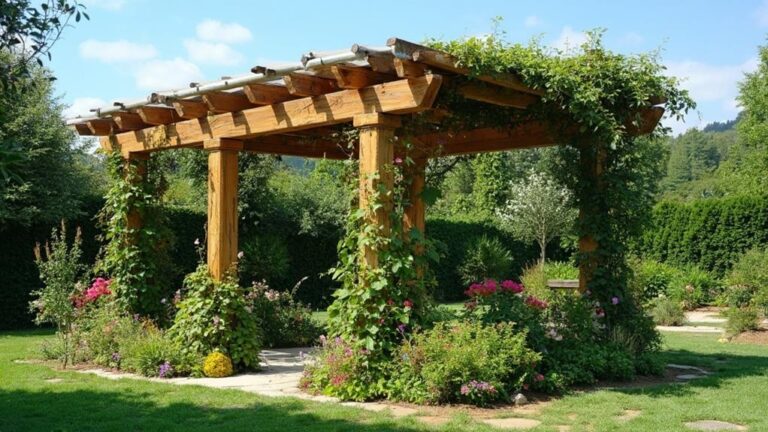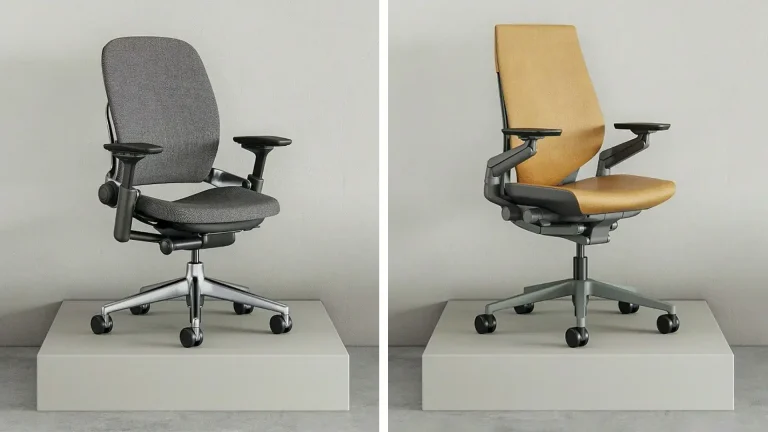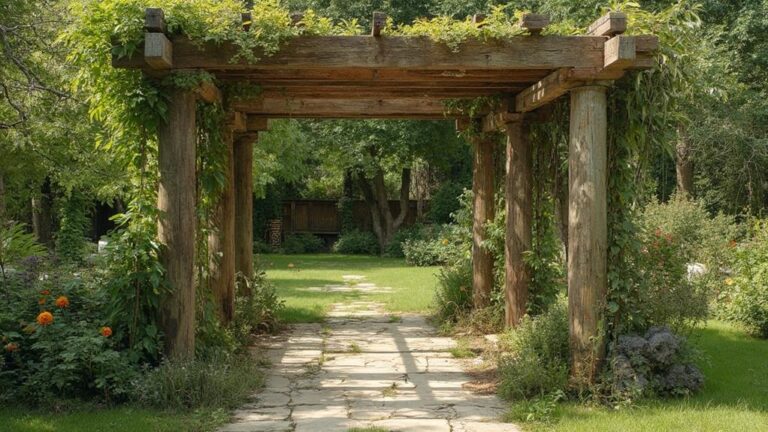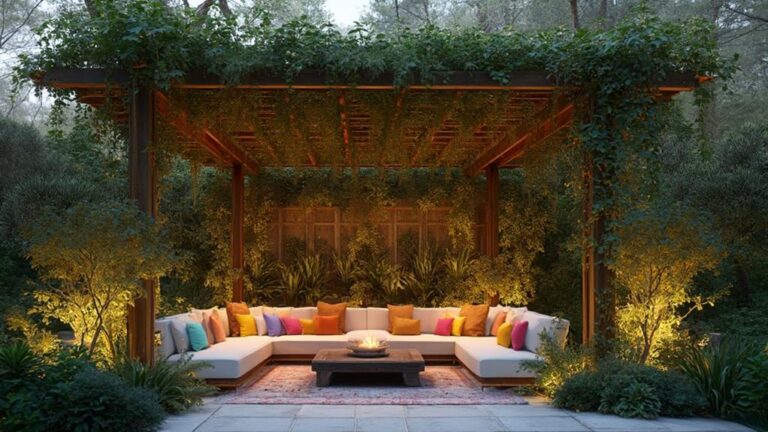7 Best Woods for Pergolas – A Comprehensive Guide
Choosing the best wood for your pergola is like choosing the right pizza topping—everyone's got opinions, but let's get real. There's treated pine, your budget buddy, Western red cedar for that charming aesthetic, and redwood with its jaw-dropping hues. Then there's teak, fancy but durable, and Douglas fir, rustic and affordable. Don't forget about cypress' stability and composite materials—trendy, low-maintenance, and eco-friendly! Each option brings something special to the table. So, grab your apron and get ready to learn more about these wood wonders and how to make your outdoor dreams a reality!
Key Takeaways
- Treated Pine is affordable and durable, resistant to decay and insects, requiring staining after six months for aesthetic appeal.
- Western Red Cedar offers natural resistance to rot, lightweight handling, and an attractive light amber color, ideal for customization.
- Redwood features stunning grain patterns and a rich red-brown color, providing durability and longevity with proper care, often exceeding 20 years.
- Teak is exceptionally durable and moisture-resistant, containing natural oils that protect against decay, making it a long-lasting investment despite higher costs.
- Composite Materials combine wood fibers and recycled plastics, offering low maintenance and various finishes, with warranties ranging from 10 to 25 years.
Treated Pine
When it comes to choosing the right wood for your pergola, treated pine stands out as a top contender for its affordability and durability. Seriously, if you're looking to build something that won't break the bank and can withstand the elements, this is your go-to. Treated pine undergoes a special pressure treatment, so it's like it's got a superhero cape against decay, rot, and pesky insects. You'll be amazed at how long it lasts compared to its untreated cousins.
At first glance, the wood might rock a greenish or bluish hue, but don't worry, it'll eventually evolve to a warm golden brown. Just keep in mind that if you want it to look spiffy, you'll need to apply a stain after about six months. Yes, patience is a virtue!
On top of all that, treated pine is sustainably harvested, mostly from Southern Yellow Pine. So, you can feel good about your choice, knowing you're being kind to Mother Earth while creating your outdoor oasis. Who knew being eco-friendly could be so stylish? Now, go forth and build that pergola!
Western Red Cedar

Western Red Cedar is a stunning option for your pergola, thanks to its light amber color and beautifully even grain. Seriously, it's like nature decided to drop a work of art right in your backyard. This wood isn't just a pretty face, either. It's naturally resistant to rot and insect damage, making it a superhero for your outdoor structures, especially in the face of nasty weather.
And let's talk about handling it—Cedar is lightweight! You won't need to call in a crew of muscle-bound friends to lift it. Plus, it takes paints and stains like a champ, so you can totally customize it to match your vision.
Oh, and if you care about Mother Earth, you'll be happy to know it's sustainably harvested in North America. That's a win-win, right? With a bit of TLC—think staining and sealing every few years—your Western Red Cedar pergola can last over 10 years. So, go ahead and make your outdoor space the envy of the neighborhood, because who doesn't want a stunning, long-lasting pergola that's also eco-friendly?
Redwood

If you're looking for another fantastic wood option for your pergola, Redwood deserves your attention. This beauty isn't just a pretty face—its rich red-brown color and stunning grain patterns will make your outdoor space the envy of the neighborhood. Plus, you won't have to worry about rot or pesky insects nibbling away at your investment, because Redwood is naturally resistant to both.
Now let's talk strength. Redwood has a high strength-to-weight ratio, making it as durable as it is gorgeous. And if you're a tree-hugger like me, you'll appreciate that it's sustainably harvested in California and the Pacific Northwest, with many suppliers offering FSC-certified options. That means you can sip your iced tea under your new pergola, guilt-free.
Here's a quick rundown of Redwood's perks:
| Feature | Benefit |
|---|---|
| Aesthetic Appeal | Rich color and grain |
| Durability | Can last over 20 years |
| Eco-Friendly Sourcing | Sustainably harvested options |
Teak

Teak stands out as one of the best choices for your pergola, thanks to its remarkable durability and moisture resistance. Seriously, this tropical hardwood is like the superhero of outdoor structures. With a Janka hardness rating of around 1,155, it's tough enough to handle whatever Mother Nature throws its way. Rain, sun, or even that pesky raccoon? No problem!
What's even cooler is that teak comes with natural oils, which makes it a fortress against decay and insect damage. So, you won't be spending your weekends fighting off termites or worrying about rot. You'll actually get to enjoy your outdoor space! Plus, its rich golden-brown color matures to a stunning silver-gray over time, giving your pergola a timeless, classy vibe.
Now, let's be real: teak isn't the cheapest option out there. Its limited availability means it can be a bit pricey. But hey, you get what you pay for, right? Investing in teak means you're investing in a beautiful, durable structure that'll last for years, making you the envy of the neighborhood. So, why not treat yourself? You deserve it!
Douglas Fir

For those seeking a blend of strength and affordability, Douglas Fir is an excellent option for your pergola. This wood's high strength-to-weight ratio makes it a popular choice, so you won't have to worry about it collapsing during your next backyard barbecue. It's got the chops for durability, but, let's be real, it isn't as naturally decay-resistant as cedar or redwood. A little treatment can help it fend off rot and bugs, though.
On top of that, Douglas Fir's warm color and straight grain pattern bring a rustic charm that can elevate your outdoor space. And just when you think it can't get better, it's generally more affordable than many hardwoods. Your wallet will thank you!
Here's a quick breakdown of why Douglas Fir might just be your new best friend:
| Feature | Details | Notes |
|---|---|---|
| Strength & Durability | High strength-to-weight ratio | Perfect for structural needs |
| Natural Resistance | Less resistant to decay | Treatment can enhance longevity |
| Aesthetic Appeal | Warm color, straight grain | Complements outdoor designs |
| Cost-Effectiveness | Generally budget-friendly | Your bank account will smile |
| Sustainability | Often sourced sustainably | Eco-friendly choice |
Cypress

Consider cypress wood for your pergola, and you'll discover a material that excels in both beauty and durability. Seriously, this stuff is like the superhero of outdoor wood. Thanks to its high oil content, cypress is naturally resistant to decay and pesky insects. Say goodbye to those creepy crawlies ruining your outdoor vibe!
But wait, there's more! The warm hues of cypress, ranging from light yellow to medium brown, are like nature's way of giving your yard a cozy hug. Plus, this wood is stable, resisting warping and shrinking like a champ, no matter what Mother Nature throws at it.
And here's the kicker: when you treat it right, your cypress pergola can last over 20 years! That's like a lifetime in pergola years. Who wouldn't want a structure that outlasts many of its competitors?
Oh, and if you're feeling eco-conscious, you'll be glad to know that cypress is sustainably sourced from managed forests. So, you can build your dream pergola while giving a high-five to the environment. What's not to love?
Composite Materials

If you're looking for a modern, low-maintenance option for your pergola, composite materials are an excellent choice. Imagine enjoying your backyard without the hassle of constant upkeep. These materials are a smart blend of wood fibers and recycled plastics, making them eco-friendly and tough. Say goodbye to rot, decay, and those pesky insects that love to munch on wood!
You'll find composite pergolas in a rainbow of colors and finishes, so you can match your style without the need for endless painting or staining—who has time for that? Plus, they're built to last, with warranties ranging from 10 to 25 years. Sure, the upfront cost might sting a bit, but just think of all the savings on maintenance down the line.
Here's a quick look at the benefits:
| Feature | Composite Materials | Traditional Wood |
|---|---|---|
| Maintenance | Low | High |
| Durability | High | Variable |
| Lifespan | 10-25 years | 5-15 years |
Frequently Asked Questions
What Is the Best Type of Wood to Use for a Pergola?
When choosing wood for your pergola, consider options like Western Red Cedar for its beauty and durability, or Pressure-Treated Southern Yellow Pine for budget-friendliness. Evaluate your climate and maintenance preferences to make the best choice.
Is Softwood or Hardwood Better for Pergola?
When deciding between softwood or hardwood for your pergola, consider your budget and maintenance preferences. Softwoods are affordable but require more upkeep, while hardwoods offer durability and beauty at a higher cost. Choose wisely!
What Is the Most Durable Material for a Pergola?
When considering the most durable material for your pergola, tropical hardwoods like teak or ipe stand out due to their exceptional resistance to decay and insects. Modified woods also offer great durability with less maintenance required.
What Size Timber Should I Use for a Pergola?
You'll need sturdy timber for your pergola! Use 190 x 45mm beams, 140 x 45mm rafters spaced at 450mm, and 90 x 90mm posts. Always check local codes to guarantee safety and compliance.
Conclusion
So there you have it, the top woods for your pergola dreams! Whether you go for treated pine's budget-friendly charm, cedar's natural beauty, or the luxurious vibe of teak, each wood has its own flair. You can create a stylish outdoor hangout or a cozy retreat—your choice! Just remember, it's all about finding the right fit for your space and your style. Now, get out there and build something amazing before summer ends!





